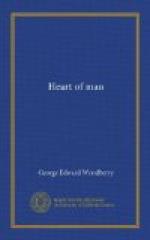The fact is that the limitation of sculpture and painting and their kindred arts results from their use of the physical basis of life only partially, and not as a whole as literature uses it. They set forth their works in the single element of space; they exclude the changes that take place in time. The types they show are arrested, each in its moment; or if a story is told by a series of representations, it is a succession of such moments of arrested life. The method is that of the camera; what is given is a fixed state. But literature renders life in movement; it revolves life through its moments as rapidly as on the retina of sense; its method is that of the kinetoscope. It holds under its command change, growth, the entire energy of life in action; it can chase mood with mood, link act to act. It alone can speak the word, which is the most powerful instrument of man. Hence the types it shows by presenting moods, words, and acts with the least obstruction of matter and the slightest obligation to the active senses, are the most complete. They have broken the bonds of the flesh, of moment and place. They exhibit themselves in actions; they speak, and in dialogue and soliloquy set forth their states of mind lying before, or accompanying, or following their actions, thus interpreting these more fully. Action by itself reveals character; speech illumines it, and casts upon the action also a forward and a backward light. The lapse of time, binding all together, adds the continuous life of the soul. This large compass, which is the greatest reached by any art, rests on the wider command and more flexible control which literature exercises over that physical basis which is the common foundation of all the arts. Hence it abounds in complex types, just as other arts present simple types with more frequency. All types, however, in so far as they appeal to the mind and interpret the inward world, under which aspect alone they are now considered, have their physical nature, materially or imaginatively, even though it be solely visible beauty, in order to express personality.
The type, in the usage of literature, must be further distinguished from the bare idea of the species as it has thus far been defined. It is more than this. It is not only an example; it is an example in a high state of development, if not perfect. The best possible tree, for instance, does not exist in nature, owing to a confused environment which does not permit its formation. In literature a type is made a high type either by intensity, if it be simple, or by richness of nature, if it be complex. Miserliness, braggadocio, hypocrisy, in their extremes, are the characters of comedy; a rich nature, such as Hamlet, showing variety of faculty and depth of experience, is the hero of more profound drama. This truth, the necessity of high development in the type, underlay the old canon that the characters of tragedy should be of lofty rank, great place, and




